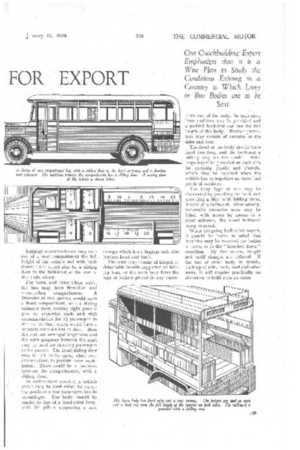Forethought is Needed in Designing
Page 66

Page 67

If you've noticed an error in this article please click here to report it so we can fix it.
BODYWORI FOR EXPORT
HEN bodywork is built for
• export, due consideration should be .given to the climate of the country concerned.
• and the condition of the roads. It• should also be ascertained whether the rule of the road is the same as in Great Britain or otherwise, and what are the facilities available for maintenance and repair.
Certain regulations may have to be observed whichaffect the design of bodywork. The customer is usually aware of such regulations, but if there be any doubt on this point there are Government agents and other officials in this count who
can, w o can, as a rule, supply the informa tion required.
Indian teak is frequently recommended for the framework, if the vehicle is to be operated in a tropical climate. because this wood contains a natural oil which resists the attacks of the white ant. Other native hardwoods may also be suitable, and the opportunity is often afforded for using Empire timbers, which are easily procurable in this country. As an instance, a recent inquiry revealed the fact that no fewer than 23 timber merchants were specializing in Nigerian hardwoods.
In a hot climate, protection from the sun and dust, also adequate ventilation, are impor tant factors. The roof of a bus or that of a lorry-cab should be double, so that a current of air may circulate and c28
act as an -nsulator. Other methods of insulation, either for the roof or sides of the, vehicle, may be adopted. They may be those used in the case of refrigerator vans.
A bus body should have a welldomed roof or a deep cantrail panel fitted with louvres. Further protection from the sun is afforded by means of jalousies or louvre panels in the window openings. The pillars should have double runs, the outer ones for the jalousies and the inner ones for the adjustable windows, If roller blinds be provided, these should be on the outside of the glass.
If road surfaces be indifferent, then the chassis will have extra ground• clearance and the body
builder should allow more • than the usual ,clearance between wheel and wing, so as to 'allow for extra large accumulations of mud and other road debris, also, in some instances, for the fitting of track-laying chains.
Although a body should always be designed with a view to facilitating repair, this factor is particularly important when a vehicle is to be exported to a locality where skilled labour is difficult to procure. Ease of repair is also facilitated if those body fittings and accessories which are most likely to require replacement be in stock in the garage, or may be procured locally.
The bus for a long journey• in a hot climate should have well-spaced and comfortable seats. A body 7 ft. 6 ins, wide should have n single seat on one side of the gangway and a double one on the other, so that each passenger May have 18 iris, width of seat, with a wide gangway between the single and double seats.
Luggage accomModation may consist of a rear compartment the full height of the vehicle and with back doors; there Could also be a sliding door in the bulkhead at the end of the main. saloon. .
For town and inter-urban Work, the bus may have first-class and second-class compartments. A 20-seater of this pattern would have a front compartment, with a sliding entrance door, seating eight passengers on crosswise seats and with accommodation for 12 passengers in the rear portion, which would have a separate entrance .butrio door. Here the seats are arranged lengthwise and the wide gangway between the seats may be used for standing passengers or for parcels. The front sliding door may lie left .partly open, when ccinditions allow, to provide extra ventilation. There . could be a partition between the compartments, with a sliding door.
In undeveloped country, a vehicle which may be used either for carrying goods or a few passengers has its advantages. The body should be similar, to that of a fiXed-sided lorry-, with the pillars supporting a roof canopy which has a luggage rail, also louvres front and back.
The seats may consist of hinged or detachable boards supported on folding legs, or the seats may form the tops of lockers placed in any conve nient part of the body. In each case, loose cushions may be provided and a padded back-rest can ran the full length of the body. Further protection may consist of curtains at the sides and rear.
The front of the body should have fixed boarding, and the tailboard a folding step on the inside. Metal loops might be provided on each side for carrying planks and shovels, which may be required when the vehicle has to negotiate an extra bad patch of roadway.
The lorry type of bus may be elaborated by panelling the back and providing a door with folding steps, instead of a tailboard. Alternatively, removable crosswiSe seats may be fitted, with access by means of a front entrance, the usual tailboard being retained.
When designing bodies for export, it should be borne in mind that inquiries may be received for bodies in parts, or in the " knocked-down " condition. By this means, freight and tariff charges are reduced. If the bus or other body be usually built up of side, back, roof and other units, it will require practically no alteration to fulfil such an order.




















































































































































